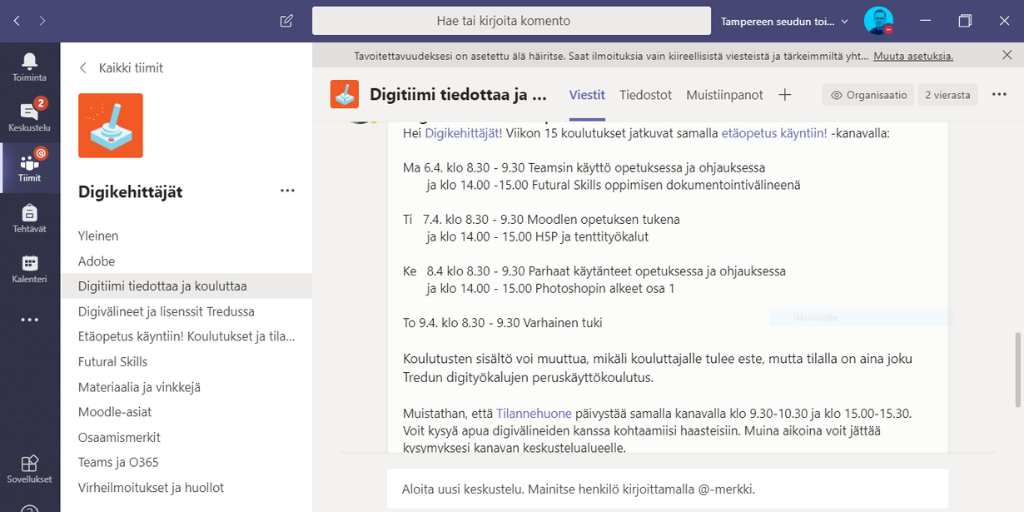The quick shift to distance learning transferred all the upper secondary teachers and students to a digital working environment at once. The groundwork laid by the educational institutions and the Smart Tampere program ensured that basic digital tools were ready and relatively easy to deploy.
Social Studies Teacher Henna Leivo starts a lesson with a roll call and an acknowledgement: previous assignments were duly finished. Now that classrooms are closed because of the coronavirus prevention measures, the group joins their economics lesson in a Teams meeting and uses the Moodle learning platform.
Our digital working environment was already there: the essential tools for distance education were ready to use before the big shift. Teams and Moodle are in the core of this work, says Ville Palkinen, Project Manager, Digital Learning Environments, of the Smart Tampere Digitalization Program.
It is not possible to teach all and everything online, as for example the Tampere Vocational College Tredu provides a lot of school-based instruction in practical skills. There are, though, at least some contents in any subject that can be covered using digital tools. An economics lesson runs well in a Teams meeting, where Leivo steers her students through some current affairs: the situation in China, economic growth and the impact coronavirus may have on globalisation.
A quick shift based on good groundwork
The deployment of digital tools was greatly accelerated by the shift to distance education. For example the use of Teams in the City of Tampere upper secondary education (both general and vocational) increased by thousand per cent in a couple of weeks. The framework for distance learning had been laid over a longer period of time.
Distance learning provision doesn’t emerge by itself but needs people who develop it professionally and who can also test the tools in practice, says Palkinen.
There is a website Osaava Tredu that provides pedagogical and technical support for both teachers and students (for now in Finnish only). Basic instructions created over time are most valuable in the current situation, and new material is produced constantly. Tredu also has a team of specialists called Digitiimi. It was founded in January to advance distance education. It is now working at full speed, supporting the shift substantially.
Training sessions and collegial support
The quick shift to distance education presented some major challenges. First, some people didn’t have the skills to use digitals tools; secondly, teachers had to produce new materials for distance learning environments and reconsider their pedagogical approaches. In both cases, support has been available.
We had our first training session in Wednesday morning, when the school doors had closed the previous day, says Leivo.
Digitiimi organises an online training session for Tredu staff every morning, followed by an open clinic for questions on digital tools. There is also a Teams team for user advice.
– There too we have an atmosphere of notable collegial support, questions are answered and materials and knowhow willingly shared, says Palkila.
At first, questions were mostly about technical matters, but soon pedagogical issues became more common – how to work with students in the new digital environment?
A shared online lesson provides interaction
The economics lesson proceeds with team assignments, and the teacher visits each team to discuss their progress. When results have been presented and an essay given to write, it is time to say goodbye and let everyone go on with their day.
Students Resi Forsby and Leo Keskinen stay online for a moment to chat. They are studying for a double examination: the Finnish matriculation examination and a vocational qualification in ICT. Technical aspects of distance learning were easy to manage, social distancing may be harder.
Distance learning is more relaxed considering you can wake up, eat an unhurried breakfast, open your laptop and study at home. For some it is a more efficient way, but some – and I think most people nowadays – learn better when interacting with others in a classroom, Forsby ponders.
– School is a good thing because you can go to a place where you see people and get yourself into a study mode. I think I won’t stand staying at the same desk, not for a long, says Keskinen.
Forsby and Keskinen emphasise that communication with other people, even if just asking ’how are you’ on social media, is especially important now and helps prevent loneliness. According to Leivo, shared lessons in Teams also create interaction and help structure the days – which is the core of teachers’ job now and in normal times.
– Teacher provides education and instruction, reaches for students on a scheduled lesson. Studies proceed, just using different channels than before, Leivo says.
